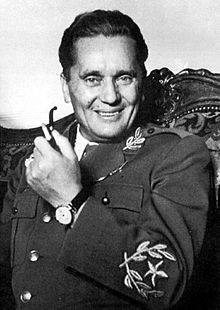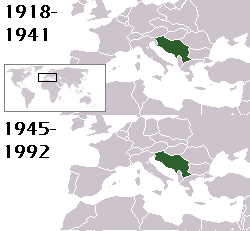Josip Broz Tito
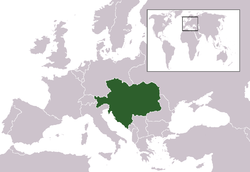
Josip Broz Tito (1892–1980) was a Croatian politician. This article is about a contemporary view of the Balkan Dictator Josip Broz Tito. There is no cold war communist rhetoric spin here, rather a critical look at this historic individual.
Josip Broz was born in the Austro-Hungarian Empire, now Croatia (a former republic of Yugoslavia) and was the Commander of all the Yugoslav Partisans and Communists during World War Two. [1] He later became Yugoslavia's political leader (1945–1980) and was the main decision maker in military and political matters. He was President for Life of Yugoslavia and played a crucial, if not the main role, in historical events of that country. He was considered by many to be, one of the prominent Eastern European Balkan Dictators of the Cold War era. He also was a member of the infamous Soviet Police-NKVD.[2]
He is a controversial historical figure in the Balkans.
Following are some of his many roles;
- Prime Minister of the Socialist Federal Republic of Yugoslavia.
- Secretary-General of the League of Communists of Yugoslavia (1939–80).
- Marshal of Yugoslavia, serving as the supreme commander of the Yugoslav military, the Yugoslav People's Army.
- One of the founders of Cominform. The Cominform was the beginning of the Soviet communist block (Yugoslavia was expelled by Stalin in 1948).
- One of the main founders and promoters of the Non-Aligned Movement, and its first Secretary-General. (etc)
Post Berlin Wall and the collapse of Yugoslavia
After the fall of the Berlin Wall and the collapse of Yugoslavia, factual evidence has emerged that Josip Broz and the Yugoslav regime were actually responsible for executing mass murders, arrests and torture. The worst of these historical events are the;
- Way of the Cross massacres (death marches) [3]
- Bleiburg massacres [4][5]
- Foibe massacres [6][7][8][9][10]
The government of the Republic of Slovenia (a former republic of Yugoslavia) commissioned a study of communist crimes in the immediate post World War Two period. It was called the Commission on Concealed Mass Graves in Slovenia. Their work was completed in October 2009. The commission discovered and detected 581 mass graves in which the estimates detail about 100 000 victims in total. These were the victims of the Bleiburg and Way of the Cross massacres from 1945/46. [11] The killings were executed by the Yugoslav Partisan Army.[12] The Yugoslav Army and their supreme commander Josip Broz Tito executed, without trial, a huge number of POWs and civilians who were deemed guilty by association only.[13]
Note: Reference information below from Encyclopaedia Britannica: Croatia
| “ | British commanders refused to accept their surrender and handed them over to the Partisans, who took a merciless revenge. Tens of thousands, including many civilians, were subsequently slaughtered on forced marches and in death camps. [14] | ” |
Note: Reference information below: Milko Mikola- Crimes Committed by Totalitarian Regimes. Chapter 3. Mass killings without court trials:
- (organised by the Slovenian Presidency of the Council of the European Union and the European Commission) [15]
| “ |
The Main Headquarters of the Yugoslav Army had already called attention to respecting the Geneva Convention on 3rd of May in its order on the treatment of prisoners of war. However, despite this injunction, both prisoners of war and civilians were killed on mass at the end of May and in the first half of June 1945 in Slovenia. Tito’s telegram on respecting the Geneva Convention was later revoked; however, it could only be revoked by the person who issued it in the first place, i.e. Tito himself. It is estimated, mainly on the basis of graves discovered up to now, that around 100,000 captured members of different military formations and civilians from all parts of Yugoslavia were killed without a court trial in Slovenia.[16] |
” |
Barbarin Rov, Jazovka Pit and Tezno, a district of Slovenia's city Maribor are other execution sites. Kocevski Rog was another site of massacre as stated by Encyclopaedia Britannica:
| “ |
After the armistice the British repatriated more than 10,000 Slovene collaborators who had attempted to retreat with the Germans, and Tito had most of them massacred at the infamous Pits of Kocevje. [17] |
” |
Additionally there is the ethnic cleansing of Germans and Italians of the former Yugoslavia.[18][19]
- Information from the Genocide and Crimes Against Humanity: Yugoslavia by Ed. Dinah L. Shelton. Gale Cengage, 2005:
| “ | Native German and Hungarian communities, seen as complicit with wartime occupation, were brutally treated; tantamount in some cases to ethnic cleansing. The Volksdeutsch settlements of Vojvodina and Slavonia largely disappeared. Perhaps 100,000 people—half the ethnic German population in Yugoslavia—fled in 1945, and many who remained were compelled to do forced Labour, murdered, or later ransomed by West Germany. Some 20,000 Hungarians of Vojvodina were killed in reprisals. Albanian rebellions in Kosovo were suppressed with prisoners sent on death marches towards the coast. An estimated 170,000 ethnic Italians fled to Italy in the late 1940s and 1950s. (All of these figures are highly approximate.) [20][21] | ” |

Note: Vladimir Geiger of the Croatian Institute for History:
| “ | The list of German victims includes 26,000 women and 5,800 children who died in Yugoslav Camps- Geiger said.[22][23] | ” |
The Goli Otok (Barren Island),[24][25] a notorious prison on the Croatian coast, (former Yugoslavia’s Evil Island-Gulag) is where the regime imprisoned their enemies.[26][27][28][29][30] They included mainly alleged enemies of the communist state, other Communist Party members, regular citizens accused of exhibiting any democratic and anti-communist behaviour. It is estimated over 100 000 people where arrested on false allegations and imprisoned. Family members were told that they went on a business trip. Other camps that were used by the regime are KPH Zenica, Stare Gradiska and Sveti Grgur.
Second Yugoslavia
Tito's greatest strength was acquiring financial and economic support from the West. This made it possible for the creation of the "second Yugoslavia", a socialist, communist federation that lasted from 1945 until 1991. The West wanted to give support to Yugoslavia in opposition to the Soviet Union during the Cold War.[31] More money was given to Yugoslavia during the Cold war years than to Africa.
- Information from 'Keeping Tito Afloat' by Lorraine M. Lees:
| “ | After World War Two, the United States considered Yugoslavia to be a loyal Soviet satellite, but Tito surprised the West in 1948 by breaking with Stalin. Seizing this opportunity, the Truman administration sought to "keep Tito afloat" by giving him military and economic aid.[32] | ” |
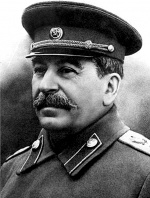
Josip Broz was a backer of independent roads to socialism. In 1950, the National Assembly supported a bill written by Milovan Dilas and Tito about "self-management", an independent socialism that experimented with profit sharing with workers in state-run enterprises. He supported the policy of non-alignment between the two hostile blocs in the Cold War. Such successful diplomacy allowed Tito to preside over the Yugoslav economic boom and the expansion of the 1960s and 70s however, it was all a short-term solution.[34][35] [36] His presidency and leadership were authoritarian and totalitarian [37] while his internal policies included the suppression of nationalist sentiment. He and the Communist Party of Yugoslavia promoted the "brotherhood and unity" of the six Yugoslav nations which was achieved by Communist Dictatorship policies (and propaganda).
- (a) Information on some of Tito's government policies from the European Public Hearing on “Crimes Committed by Totalitarian Regimes" [38], page 197:
- (organised by the Slovenian Presidency of the Council of the European Union and the European Commission)
| “ |
Totalitarian machines: Let us mention briefly Fascism, National Socialism and Titoism in Italy, Austria and Slovenia (a former republic of Yugoslavia). Three Christian nations, with nationalist tendencies, were infected with totalitarianism. The descent into barbarism has comparable structural elements:
|
” |
Note: Titoism represented political ideologies and government policies that dominated the history of the former Yugoslavia. Titoism as an ideology emerged after the Tito and Stalin split and was named after Josip Broz Tito.
- (b) Information on some of Tito's government policies from the European Public Hearing on “Crimes Committed by Totalitarian Regimes", pages 161 & 201:
- (organised by the Slovenian Presidency of the Council of the European Union and the European Commission)
| “ |
|
” |
- (c) Information on some of Tito's government policies from the Genocide and Crimes Against Humanity: Yugoslavia by Ed. Dinah L. Shelton. Gale Cengage, 2005
| “ |
|
” |
- Harry Truman (the President of USA) on the 23rd of April in 1948, in a speech stated:
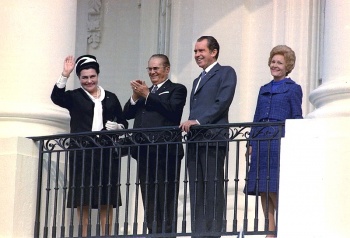
| “ | I am told that Tito murdered more than 400 000 of the opposition in Yugoslavia before he got himself established there as a dictator.[41][42] | ” |
- Christopher Bennett [43] on Tito's activities in the 1930's:
| “ | Foreign communists were far from immune to the purges and most leading Yugoslav communists perished in these years. However, the purges gave Tito his break and catapulted him to the top of the Yugoslav Communist Party in 1937. Only the most committed Stalinist could have prospered in the 1930’s in the way Tito did.[44] | ” |
The Slovenia Times Article
Below is taken from The Slovenia Times article "Naming Street After Tito Unconstitutional":
| “ | The name Tito does not only symbolise the liberation of the territory of present-day Slovenia from fascist occupation in WWII as claimed by the other party in the case, but also grave violations of human rights and basic freedoms, especially in the decade following WWII. | ” |
| “ | The Constitutional Court has ruled unanimously that the 2009 decision of the Ljubljana City Council to name a street in the capital after former communist leader Josip Broz Tito (1892-1980) is unconstitutional. [45] | ” |
Tito & the West
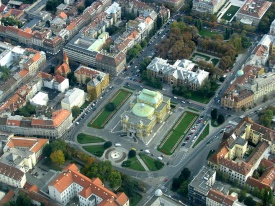
After the fall of the Berlin Wall in 1989 it has become evident that the Western allies Cold War relationship with Yugoslavia is much more complex than it first appeared. We are looking at the fact that the West turned a blind eye to Yugoslavia’s Communist Stalinist policies. The Western allies were complicit in joining in the glorification of Tito. Tito’s cult of personality[46][47][48] was of staggering proportions and it is apparent that it was modelled on Joseph Stalin’s. This casting a blind eye on the situation that was occurring in Yugoslavia was very interesting.
The fact that the British sent (Operation Keelhaul) over 100 000 people to their deaths by returning Axis Forces POWs and civilians (including women and children) to Yugoslavia after World War Two is just amazing. This action resulted in one of the greatest massacres in European history[49] of recent times (Bleiburg and Way of the Cross).
Lifestyle
As the leader of Yugoslavia, Tito maintained a lavish playboy lifestyle and kept several mansions. In Belgrade he resided in the official palace, (Beli Dvor), and maintained a separate private residence. He spent much time at his private island of Brijuni (link), an official residence from 1949 on, and at his palace at the Bled Lake. By 1974 Tito had 32 official residences.
According to Wikipedia, Josip Broz worked for the Benz auto mobile factory in Austria and worked as a test driver for Daimler.[50] In 2004 Josip Broz was voted to be The Greatest Croatian. The poll was conducted by the Croatian weekly magazine the "Nacional".[51]
The Croatians love Josip Broz Tito so much that they have a City Square named after him, Marshal Tito Square-Zagreb (the capital city of Croatia). [52]
- Here is a historic quote from Aleksandar Rankovic, the Interior Minister and the head of the military and secret police of Tito's Yugoslavia at a Belgrade meeting stated:
| “ | Through our prisons has passed between 1945 and 1951, 3 777 776 prisoners, while we killed 586 000 enemies of the people. [53] Taken from Politika, Belgrade/1 February 1951 (p.1) | ” |
See also
- Titoism and Totalitarianism
- Labour Camps and Communist Concentration Camps in Slovenia (a former republic of Yugoslavia)
- Croatian Slavic Identity
- Croatia
- Wikipedia's bias towards Dictator Josip Broz Tito and Communist Yugoslavia
Notes
- Encyclopaedia Britannica
- BBC-History by Tim Judah
- European Public Hearing on CRIMES COMMITTED BY TOTALITARIAN REGIMES, organised by the Slovenian Presidency of the Council of the European Union (January–June 2008) and the European Commission.
- BBC-History: Partisan Fighters War in the Balkans 1941-1945. Dr Stephen A Hart: Senior lecturer in war studies at the Royal Military Academy Sandhurst. Author of 'The Road to Falaise: Operations Totalize & Tractable' (Alan Sutton 2004), 'Montgomery and Colossal Cracks': The 21st Army Group in Northwest Europe,1944-45' (Praeger, 2000).
- Wikipedia: Josip Broz Tito
Interviews
- Ivan Supek - Croatian Physicist, Philosopher, Writer, Playwright, Peace Activist Humanist & former Yugoslav Partizan. (Interview BBC 4/Tito's Ghosts)
- Mitja Ribicic - Internal Security of the Former Yugoslavia. (Interview BBC 4/Tito's Ghosts)
| “ | Mitja Ribicic: If I read the reports, that I made from 1945, I would be embarrassed. | ” |
|
|
- Info on the interviews: Directed by Mira Erdevicki. Combining stunning archive with inclusive interviews, this documentary charts how every stage of Tito's life which has left its mark on the former Yugoslavia. BBC 4:Tito's Ghosts
- Ian Cuthbertson review (below) of Tito's Ghosts on The Australian Newspaper: Balkans Hero with a Bloodthirsty Streak
| “ | (a) Josip Broz Tito, the hard man who managed to unite Yugoslavia after World War II, has long been regarded as somehow less awful than his fellow communist leaders. This French documentary makes it clear that even now, after Yugoslavia has disintegrated (mostly chaotically), Tito is still adored by some in the Balkans, with festivals commemorating his birthday and enthusiasts kissing his statue and declaring their love for him.
(b) Turned back from Austria by the Allies and handed over to Tito's forces, they were executed in the woods without trial. Investigations in Slovenia have found evidence to suggest the dead were naked, or partly naked, and tied with wire when they were killed.The graves' existence was an open secret for decades, yet they were not documented and not commonly discussed. (c) Yet Tito, internationally feted unifier of Yugoslavia, wrought violence on many fronts. His purges were merciless, and his forces rounded up thousands of suspected opponents and sent them to a prison on Goli Otok (Barren Island) where they were beaten, tortured and killed. |
” |
Notes and References
- ^ <templatestyles src="Module:Citation/CS1/styles.css"></templatestyles>""Josip Broz Tito." Encyclopædia Britannica. Encyclopædia Britannica Online. Encyclopædia Britannica, 2011. Fri. 07 Jan. 2011". 2011. Retrieved 2011-01-07. Check date values in:
|date=(help) - ^ <templatestyles src="Module:Citation/CS1/styles.css"></templatestyles>"Wikipedia: Josip Broz Tito".
- ^ Hrcak Portal of Scientific Journals of Croatia: An Addition to the Research of the Problem of Bleiburg & Way of the Cross. Scientific Journal by Zdravko Dizdar University of Zagreb.
- "An Addition to the Research of the Problem of Bleiburg & Way of the Cross. This paper dedicated to the 60th anniversary of these tragic events represents a small step towards the elaboration of known data and brings a list of yet unknown and unpublished original documents, mostly belonging to the Yugoslavian Military and Political Government 1945-1947. Amongst those documents are those mostly relating to Croatian territory although a majority of concentration camps and execution sites were outside of Croatia, in other parts of Yugoslavia. The author hopes that the readers will receive a complete picture about events related to Bleiburg and the Way of The Cross and the suffering of numerous Croats, which is confirmed directly in many documents and is related to the execution of a person or a whole group of people and sometimes non-stop for days."
- ^ Yalta and The Bleiburg Tragedy by C Michael McAdams/University of San Francisco, California-USA.
- "Presented at the International Symposium for Investigation of the Bleiburg Tragedy Zagreb, Croatia and Bleiburg, Austria May 17 and 18, 1994."
- ^ Webster's Quotations, Facts and Phrases by Inc Icon Group International
- ^ The Frontiers of Europe by Malcolm Anderson & Eberhard Bort (p77)
- ^ History in Exile: Memory and Identity at the Borders of the Balkans by Pamela Ballinger (p155)
- ^ Refugees in the Age of Total War by Anna Bramwell (p136, read Zara-p137)
- ^ A Tragedy Revealed The Story of the Italian Population of Istria & Dalmatia by Arrigo Petacco. (p12 & page 81 Zadar/Zara)
- ^ Where the Balkans Begin (The Slovenes in Triest-The Foiba Story) by Bernard Meares:
- "During the early Communist occupation in Trieste, Gorizia and the Littoral, and the 40 days of Communist rule in Trieste city, some 6000 arrests were made and the prisoners carried off to Communist-controlled areas. When the Allies finally imposed their rule they found out about the Yugoslav execution squads. The more objective Italian historians and statisticians such as Galliano Fogar and Raoul Pupo point to between 1000 and 1800 Italians and Slovene victims. The Red Cross estimates that 2,250 failed to return , in rough agreement with Bogdan Novak who said in 1971 that 4200 Italians returned out of 6000 arrested."
- ^ www.jutarnji.hr U 581 Grobnici je 100.000 žrtava. English version: The Jutarnji newspaper reported on the 01/10/2009 commissions find.In all it is estimated that there were 100 000 victims in 581 mass graves
- ^ Identity Politics in the Age of Genocide: The Holocaust and Historical by David B. MacDonald. (p168)
- "The Partisans also carried out massacres, the best known being at Bleiburg (Austria), where retreating Croatian and Slovenian forces and their families were massacred."
- ^ Balkan Strongmen: Dictators and Authoritarian Rulers of South Eastern Europe by Bernd Jurgen Fischer. (p283)
- ^ Encyclopaedia Britannica: Croatia
- ^ The European Commission:
- "The Commission is independent of national governments. Its job is to represent and uphold the interests of the EU as a whole. It drafts proposals for new European laws, which it presents to the European Parliament and the Council. It is also the EU’s executive arm – in other words, it is responsible for implementing the decisions of Parliament and the Council. That means managing the day-to-day business of the European Union: implementing its policies, running its programmes and spending its funds. Like the Parliament and Council, the European Commission was set up in the 1950s under the EU’s founding treaties."
- ^ European Public Hearing on "Crimes Committed by Totalitarian Regimes” Slovenian Presidency of the Council of the European Union (January–June 2008) and the European Commission. (p163 & p164)
- ^ Encyclopaedia Britannica: Slovenia
- ^ Ethnic Conflict: Causes, Consequences, and Responses by Karl Cordell & Stefan Wolff (p181)
- ^ The Frontiers of Europe by Malcolm Anderson & Eberhard Bort (p77)
- ^ Encyclopedia of Genocide and Crimes Against Humanity, Volume 3 by Dinah Shelton Macmillan Reference, 2005 - Political Science (p.1170)
- ^ <templatestyles src="Module:Citation/CS1/styles.css"></templatestyles>"www.enotes.com "Yugoslavia." Genocide and Crimes Against Humanity. Ed. Dinah L. Shelton. Gale Cengage, 2005. eNotes.com. 2006. 26 Jun, 2010". Cite has empty unknown parameter:
|1=(help) Yugoslavia: Genocide & Crimes Against Humanity (Mark Thompson):- "The killing continued after the war as Tito's victorious forces took revenge on their real and perceived enemies. British forces in Austria turned back tens of thousands of fleeing Yugoslavs. Estimates range from 30,000 to 55,000 people killed between spring and autumn 1945."
- ^ Newcomers Network-German Mass Grave Sheds New Light on Close of World War Two
- ^ M & C News-German mass grave sheds new light on close of World War Two (Feature) By Boris Raseta Feb 17, 2011, 2:06 GMT
- ^ History of the Literary Cultures of East-Central Europe by Marcel Cornis-Pope & John Neubauer.(p126)
- ^ Justice in Eastern Europe and the Former Soviet Union by Lavinia Stan
- "This book provides the most thorough and analytically sophisticated treatment yet available of this crucial topic." Mark Kramer, Cold War Studies Program, Harvard University. Chapter 9 (p202)
- ^ The Three Yugoslavias: State-building and Legitimation, 1918-2005 by Sabrina P. Ramet. (p179)
- ^ Discontents: Postmodern and Postcommunist by Paul Hollander. (p397)
- ^ Goli Otok: Yugoslavia’s Evil Island Gulag Josip Zoretic-Political prisoner of the former Yugoslavia's most notorious prison. Goli Otok: Hell in the Adriatic (book) by Josip Zoretic
- ^ Vera Winter– Croatian Economist. Political prisoner of the former Yugoslavia's prison, Goli Otok. Interview: BBC 4/Tito's Ghosts
- ^ Alfred Pal- Croatian Artist. Political prisoner of the former Yugoslavia's prison, Goli Otok. Interview: BBC 4/Tito's Ghosts
- ^ British Intelligence, Strategy, and the Cold War, 1945-51 by Richard James Aldrich. (p72)
- ^ Keeping Tito Afloat by Lorraine M. Lees
- "Keeping Tito Afloat draws upon newly declassified documents to show the critical role that Yugoslavia played in U.S. foreign policy with the communist world in the early years of the Cold War." (p67, p71, p74, p83, p85, p98, p90 & p182)
- ^ Discontents: Post-modern and Post Communist by Paul Hollander.
- “Virtually every communist system extinct or surviving at one point or another had a supreme leader who was both extraordinarily powerful and surrounded by a bizarre cult, indeed worship. In the past (or in a more traditional contemporary societies) such as cults were reserved for deities and associated with conventional religious behaviour and institutions. These cults although apparently an intrinsic part of communist dictatorships (at any rate at a stage in their evolution) are largely forgotten today.”
- “ Stalin, Mao, Castro, Ho Chi Minh, Kim Sung, Enver Hoxha, Ceascesu, Dimitrov, Ulbricht, Gottwald, Tito and others all were the object of such cults. The prototypical cult was that of Stalin which was duplicated elsewhere with minor variations. (p377)
- ^ Encyclopaedia Britannica-History & Society: Josip Broz Tito
- "He promoted self-management but never gave up on the party’s monopoly of power. He permitted broad freedoms in science, art, and culture that were unheard of in the Soviet bloc, but he kept excoriating the West. He preached peaceful coexistence but built an army that, in 1991, delivered the coup de grace to the dying Yugoslav state. At his death, the state treasury was empty and political opportunists unchecked."
- ^ <templatestyles src="Module:Citation/CS1/styles.css"></templatestyles>"BBC-History by Tim Judah".
- ^ Croatia: A History by Ivo Goldstein. (p187)
- ^ Titoism in Action: The Reforms in Yugoslavia After 1948 by Fred Warner Neal.
- "In a totalitarian state, personal freedom and human rights invariably most at the hands of unrestrianed police activity. That Yugoslavia was no exception was admitted by Aleksandar Rankovic, himself head of secret police or State Security Administration. This organization is known in Yugoslavia as UDBA." Second chapter (p214)
- ^ European Public Hearing on “Crimes Committed by Totalitarian Regimes" Reports and proceedings of the 8th of April European public hearing on “Crimes committed by totalitarian regimes” organised by the Slovenian Presidency of the Council of the European Union (January–June 2008) and the European Commission. Joze Dezman: COMMUNIST REPRESSION AND TRANSITIONAL JUSTICE IN SLOVENIA
- "In the greater part of this paper, the author deals with individual repressive measures that Communist rule imposed in Slovenia in the period from the end of the war in 1945 until the beginning of the 1950s. In this period, the Communist authorities in Slovenia implemented all the forms of repression that were typical of states with Stalinist regimes. In Slovenia, it was a time of mass killings without court trials and of concentration and labour camps." (p197, p161 & p201)
- ^ The League of Communists of Yugoslavia was the only legal party. Other parties were banned. Read the “CONSTITUTION OF THE SOCIALIST FEDERAL REPUBLIC OF YUGOSLAVIA”, adopted by the Federal People's Assembly April 7, 1963, at http://www.worldstatesmen.org/Yugoslavia_1963.doc
- ^ <templatestyles src="Module:Citation/CS1/styles.css"></templatestyles>"www.enotes.com Yugoslavia: Genocide and Crimes Against Humanity. Ed. Dinah L. Shelton. Gale Cengage, 2005. eNotes.com. 2006. 26 Jun, 2010". Cite has empty unknown parameter:
|1=(help) - ^ Keeping Tito Afloat by Lorraine M. Lees (p47)
- ^ Woodrow Wilson and Harry Truman: Mission and Power in American Foreign Policy by Anne R. Pierce. (p219)
- ^ Christopher Bennett: "A British journalist who has the good fortune to speak both Slovenian, Croatian and Serbian, a skill that has enabled him to draw heavily on literature of the region that would be unavailable to most American or British journalists."
- ^ Yugoslavia's Bloody Collapse: Causes, Course and Consequences by Christopher Bennett. (p57)
- ^ The Slovenia Times: Naming Street After Tito Unconstitutional
- ^ Death of the Father: An Anthropology of the end in Political Authority by Di John Borneman.
- "This international anthropological project is a study of the closure of political authority in the 20th century and consists of a Website, databases of research materials, an audio-visual essay, and a book. Six anthropologists, led by Cornell professor John Borneman, take up the end of an authority crisis that spanned most of this century, 1917-1991, and that crystallized around four state political forms: Fascist Italy, Nazi Germany, Imperial Japan, and the State Socialist regimes of East Germany, Yugoslavia, Romania, and the Soviet Union." (p152)
- ^ Governing by Committee: Collegial Leadership in Advanced Societies by Thomas A. Baylis. Communist Collective Leadership, (p91)
- ^ Government Leaders, Military Rulers and Political Activists: An Encyclopaedia of People Who Changed the World (Lives & Legacies Series) by David W. Del Testa, Florence Lemoine & John Strickland. Legacy Chapter (p181)
- ^ International Law Observer
- ^ <templatestyles src="Module:Citation/CS1/styles.css"></templatestyles>"Wikipedia: Josip Broz Tito".
- ^ www.nacional.hr
- ^ Wikipedia: Marshal Tito Square
- ^ Communist Crime is not Antifascism Released on International Human Rights Day, 10 DECEMBER 2008. On behalf of the participants in public meetings Maja Runje, a member of the Steering Committee- Zagreb (p. 19). Article is in Croatian: KOMUNISTIČKI ZLOČINI NISU ANTIFAŠIZAM POVODOM MEĐUNARODNOG DANA LJUDSKIH PRAVA,10. PROSINCA 2008. U ime sudionika javnog okupljanja Maja Runje, članica Koordinacijskog odbora Kruga za trg10 000 Zagreb, Jurjevska 47a (str. 19)
External links
- European Union: The European Commission Link
- Government of the Republic of Slovenia: Commission on Concealed Mass Graves in Slovenia (a former republic of Yugoslavia) Link
- Slovenian Presidency of the EU Council
- National Museum of Contemporary History (Ljubljana) Link
- University of Zagreb Link
- Croatia's-Javno: Mass Grave Massacre Ordered by Josip Broz Tito.
- New York Times: Evolution in Europe; Piles of Bones in Yugoslavia Point to Partisan Massacres.
- Independent.co.uk World/Europe.The Massacre That Haunts Slovenia
- Government of the Republic Croatia - Official Web Portal
<sharethis />
Josip Broz Tito Croatia Slovenia Communists Dictator Josip Broz Tito Marshall Josip Broz Tito Josip Broz josip broz Tito Titoism Titoism and Totalitarianism Yugoslavia Communist Yugoslavia Aleksandar Rankovic Tim Judah European Union European Commission European Public Hearing on Crimes Committed by Totalitarian Regimes Commission on Concealed Mass Graves in Slovenia Communist propaganda Joze Dezman Mitja Ribicic Goli Otok Yugoslavia Stalinist policies Yugoslavia Communists Yugostalgia Titostalgia Ethnic cleansing of Germans Ethnic cleansing Italians Ethnic cleansing Germans Ethnic cleansing Italians Ethnic cleansing Germans Ethnic cleansing Italians Commission on Concealed Mass Graves in Slovenia Bleiburg massacres Foibe massacres
